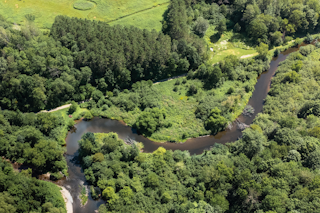
Regional plan for natural environments
Natural environment conservation that goes hand in hand with our regional development vision
Our vision is to turn Brome-Missisquoi into a natural region, home to a vibrant, innovative community. By living in harmony with nature, the region aims to strike a balance between preserving important natural environments and supporting economic development in the region.
MRC Brome-Missisquoi’s diverse ecosystems range from large forests and woodlands to wetlands, rivers, streams and riparian zones. These natural environments (wetlands, bodies of water and forests) cover more than 62% of the region.
Spanning 1,680 km2 of vibrant nature, Brome-Missisquoi is at the crossroads of two unique environments: the St. Lawrence lowlands and the Appalachian Mountains. The region’s geographic features and milder climate make for diverse habitats where flora and fauna thrive.
These environments are an invaluable natural resource—and not just because of their rich biodiversity and appeal to outdoor adventurers. They provide essential services for the local inhabitants, human and non-human alike.
These services include reducing flood risks, improving water quality and supply and increasing the climate resilience of the region and its community.
Brome-Missisquoi is also at the centre of an essential wildlife migration corridor in North America.
A natural environment is an area whose landscape, biodiversity and ecological processes have not been altered permanently (or in the long term) by human activity, that remains able to regenerate itself and where humans have neither changed nor overshadowed the landscape.
There are three types of natural environments:
A wetland is an area of land saturated or flooded with water for a long enough period of time that it impacts the soil and plant life.
Wetlands can resemble bodies of water during floods and dry land during droughts.
There are many types of wetlands, including peatlands, marshes, ponds and swamps.
There are several laws and bylaws that protect and regulate projects in natural environments (bodies of water, wetlands and forested areas).
If you wish to undertake a project that will alter or disturb a natural environment, we recommend looking into whether you need it authorized by Ministère de l’Environnement et de la Lutte contre les changements climatiques, de la Faune et des Parcs and your local municipality’s community planning department.
Conservation is so much more than just putting a shield around nature. Conservation includes protection, restoration and sustainable use of an area (including sustainable land use planning and environmental development).
A professional can tell you whether you have a wetland on your property, as well as its type, size and condition, using the methods established in Identification et délimitation des wetlands du Québec Méridional (2015). Under no circumstance is mapping through photo interpretation a good substitute for an in-person assessment.
If your land has natural features like mature forest, woodlands, wetlands, a lake, moose yards, turtles or one or more rare species, you can contact a conservancy for support and advice on how to protect your local ecosystem.
